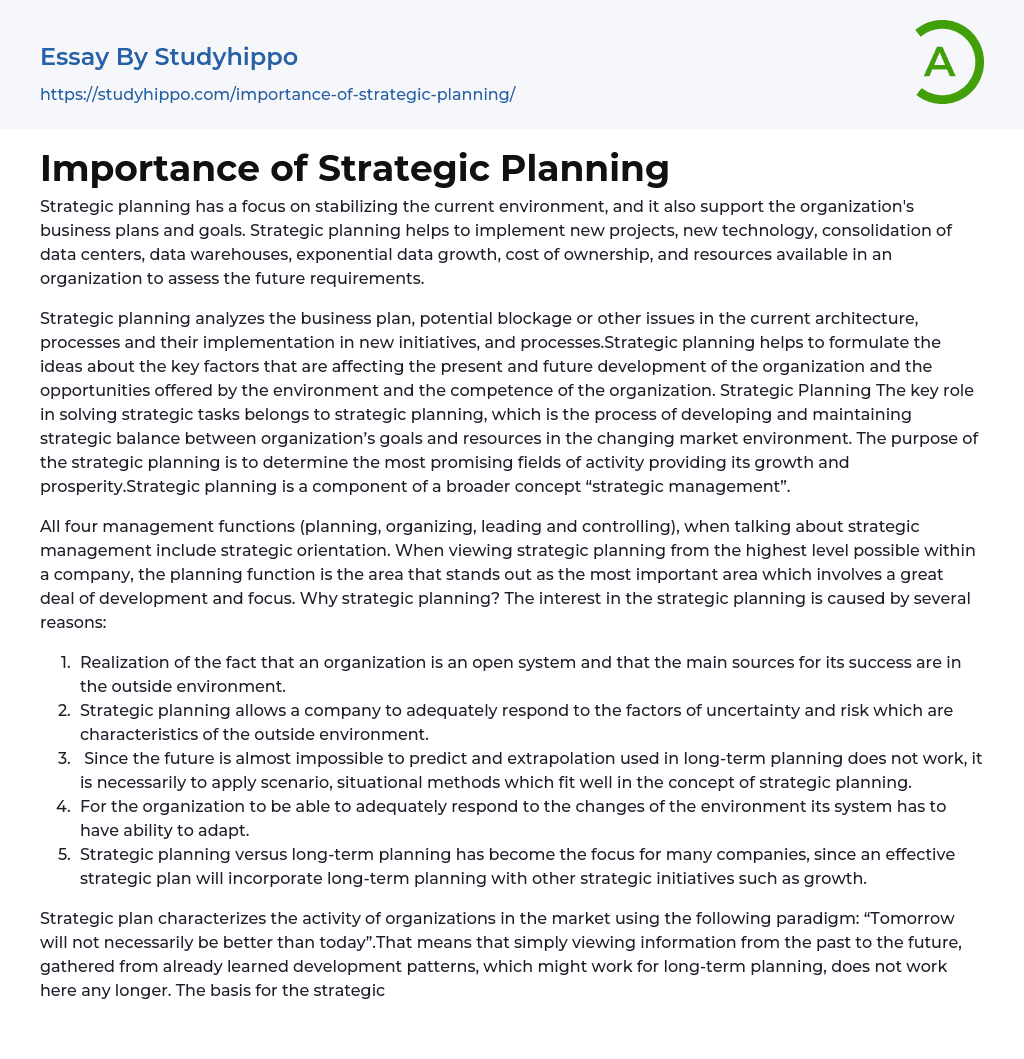Strategic planning focuses on stabilizing the current environment and supports the organization's business plans and goals. It helps implement new projects, technology, and consolidation efforts. Strategic planning also considers data growth, cost management, and resource allocation for future needs. This process analyzes the business plan and addresses any obstacles or issues in current architecture and processes. It aids in formulating ideas about key factors affecting both present and future development of the organization, as well as opportunities in the environment and organizational capabilities. Strategic planning plays a crucial role in solving strategic tasks by maintaining a balance between goals and resources in a changing market.
Strategic planning is a vital aspect of strategic management, as it helps determine the most promising areas for a company's growth and prosperity. It is considered the most important function within a company, and it encompasses the
...planning, organizing, leading, and controlling aspects of management. The value of strategic planning arises from several reasons, including recognizing that an organization is an open system that relies on external factors for success. Strategic planning also enables companies to effectively respond to uncertainty and risk in the external environment. Given the difficulty of predicting the future, strategic planning incorporates scenario and situational methods to address this challenge. Additionally, an organization's ability to adapt to environmental changes is crucial for it to respond effectively.
- Strategic planning and long-term planning have become the main focus for many companies. An effective strategic plan will include long-term planning as well as other strategic initiatives, such as growth.
Strategic plan characterizes the activity of organizations in the market using the following paradigm: "Tomorrow will not necessarily be better than today". This
means that relying solely on past information and learned development patterns for long-term planning is no longer effective.
Strategic planning involves analyzing various prospects for a company based on changes in the environment. The key element of this analysis is determining the organization's position in the market competition. Based on this analysis, certain directions of activity and strategies are formed to achieve goals. Strategic planning also involves deciding which directions of activity to develop and which to eliminate in order to adapt to the ever-changing environment and seize new opportunities. Implementing organizational strategies is crucial for planning. Urbany and Davis (2007) emphasize that while most executives understand the importance of building a distinct competitive advantage for long-term growth and profitability, many have a vague understanding of what this actually entails.
This activity involves the systematic development of thinking among managers by creating a learning organization that can benefit from previous strategic decisions. Learning from experience helps organizations correct their strategic goals and improve professionalism in strategic management. An organization's success creates a continuous desire for management to learn from experience and predict the future. However, strategic planning alone cannot provide a complete picture of the future. The outlook provided by strategic planning only presents an overall scenario that can be categorized as a possibility. Strategic planning combines intuition and the art of setting and achieving goals through analyzing and planning skills. While the development of a plan is often emphasized in strategic planning, the most crucial aspect is implementing this plan.
In order to realize chosen strategies and achieve flexibility within an organization, it is necessary to create an organizational culture that utilizes all the tools of strategic
management and forms a system of motivation. Strategic planning involves several stages, including cause and effect purpose which aims to identify the most important input variables that explain variations in outputs. Priority is determined by considering the importance to customers and the strength of correlation. Another stage is Failure Mode and Effects Analysis (FMEA), which identifies primary causes of high priority defects.
Next, charts are used to determine whether a relationship exists between an input variable and the output variable. Finally, hypothesis testing is conducted to test claims about population parameters. This includes testing if an observed process change, based on sample data, is real. In conclusion, "Strategic planning has consistently been rated as a power tool by nearly all managers in all industries and company sizes" (Rigby D., 2007). Strategic planning provides an overall picture from a 30,000 foot level. Often, managers, executives, or directors within a company learn through trial and error.
When a concern or complaint is raised, these key employees must step back and ask focused questions until the situation is resolved. Managers are able to execute through instinct in this case. However, no matter how one prepares, either through education or experience, one must always expect the unexpected. Sandenaw (2007) advises, "Plan to leave some unassigned resource capacity." When complaints or concerns develop, even those issues seemingly as easy as someone not being happy with a certain system, or request for a change to how something looks visually when presented to the industry or the customer base, companies can use strategic planning to work out where they have been and where they are currently in the business environment.
Examining a company's past is
a crucial step in evaluating it analytically. The company achieves its competitive advantage by consistently allocating limited resources to its value-adding activities. By doing so, the company can satisfy customer desires by offering superior products and services, while also sustaining business growth and adhering to its strategic plan.
- Business Analysis essays
- Business Plan essays
- Community Development essays
- Competition essays
- Effective Leadership essays
- Leadership Styles essays
- Mission Statement essays
- Negotiation essays
- Outsourcing essays
- Planning essays
- Public relations essays
- Reasoning essays
- Strategic Management essays
- Strategic Planning essays
- Swot Analysis essays




